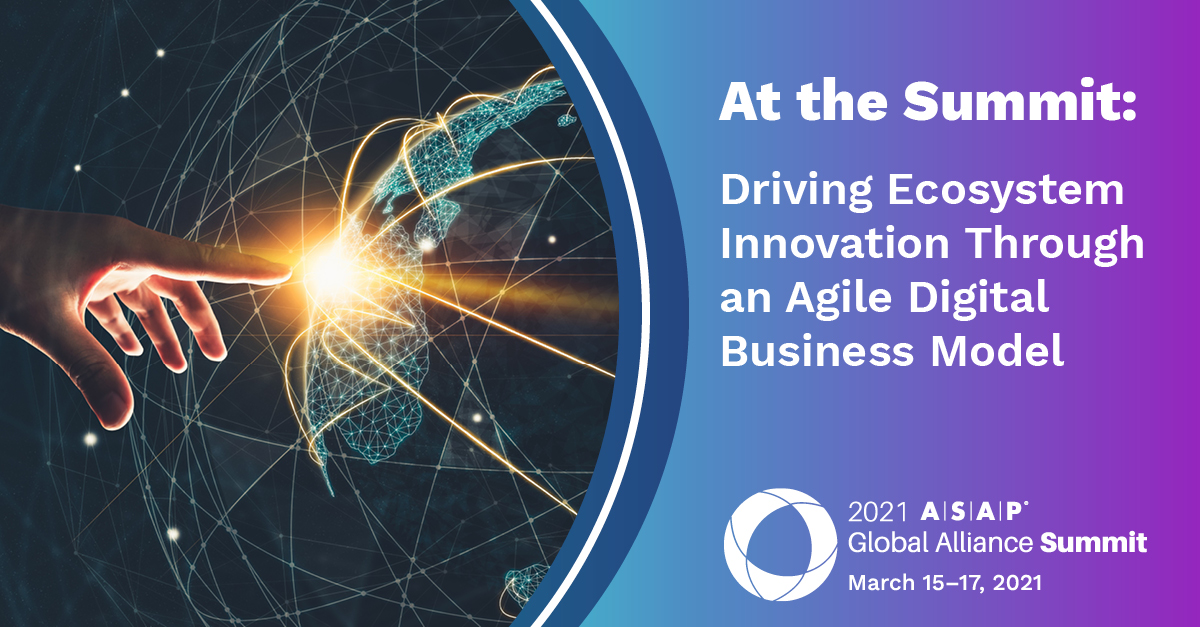Global Economy Be Nimble, Business Be Quick: Ecosystems Enable Unprecedented Agility in the Pandemic
Posted By Jon Lavietes, Monday, March 15, 2021
Like everything else in the business world, technology ecosystems have had to pivot quickly and sharply to meet shifting needs of companies, partners, and customers in this pandemic. ASAP’s coverage and event programming has similarly evolved to chart these changes over the past year. The 2021 ASAP Global Alliance Summit showcased the latest installment with a panel of executives from three companies that orchestrate ecosystems of their own titled “Driving Ecosystem Innovation Through an Agile Digital Business Model.”
Moderator Norma Watenpaugh, CSAP, longtime ASAP board member and CEO of Phoenix Consulting Group, led a discussion about the technology areas that have seen disproportionate demand in the pandemic, the changes the global public health crisis has wrought on these online marketplaces, and some of the successes ecosystems have achieved over the past year, among other topics.
Extra Effort in Partner Enablement Yields Increased Product Adoption and Sales
Carl DCosta, worldwide general manager of partner success at Blue Yonder, recounted how technical-, sales-, and deployment-related partner enablement initiatives became a top priority for his company over the last 12 months.
“As humans, we are comfortable with the familiar,” he said. “Partners sell what they know.”
The extra effort put into making the partner experience easier in the new world of remote work and economic uncertainty has paid off in terms of greater product adoption, more sales influence, and an extension of Blue Yonder’s products further into its ecosystem, according to DCosta.
An Overnight Call Center and Inside Sales Success
Watenpaugh asked the panelists how their companies have delivered in areas of increased consumer demand, such as work-from-home technologies. Drew Quinlan, CA-AM, vice president of strategic alliances at RingCentral, described how his organization’s partner network helped quickly adapt its call center and inside sales functionality to better suit the remote office. One partner helped develop prebuilt dashboards and capabilities to monitor, measure, and manage call center employees from home offices. Another bolstered sales managers’ remote coaching functions to help train sales reps in a time where mentor and mentee couldn’t collaborate in person.
“These software tools allowed us to launch new features overnight that we [otherwise] couldn’t without partners,” he said.
Supply Chain Goes from Back Office to Boardroom
Supply chain functionality went from a “back-office topic” to a “boardroom topic” as COVID-19 accelerated the need for direct-to-home shipping across just about every industry, according to DCosta. Blue Yonder stepped up recruitment efforts with approximately 20 prospective partners in this last-mile delivery area from a list of 75 organizations that was put together before the pandemic.
Leslie Tom, senior vice president of AppExchange marketing at Salesforce, shared how her organization and its ecosystem of partners launched Work.com, a suite of solutions designed to help organizations meet new workplace challenges, in two months. ISVs, GSIs, and other types of partners have moved quickly to build new apps and reposition others in the areas of employee engagement, employee health, training, and workspaces, among many others.
“It is amazing what people can do in times of need,” she said.
Outside-in Perspectives, Collaborative Sales Mentalities, and White Spaces
Watenpaugh asked the panelists what cultural changes have come about as a result of the dramatic evolution of the workplace and marketplace in a year’s time. DCosta spoke of the need to view everything from the “outside-in” perspective of partners and clients. He made the point that tech companies move fast and are often working on new capabilities that customers don’t always know they need. It is easy to forget that external parties may not immediately see your vision as clearly as you do.
“We need to think from the outside in, so partners can leverage these innovations,” he said.
Quinlan said that the pandemic has reinforced the role trust plays as a foundational pillar of RingCentral’s alliance culture. He noted that he has tried to steer clear of traditional “direct sales” mentalities, ones that discourage partner collaboration due to the perception that allies will slow the process down or take too big a bite out of commissions. He added that trust also comes from selecting the best partners in terms of functionality and efficiency in execution.
“Low-quality partners can be damaging for everybody,” he said.
Tom added that verified security reviews of apps developed in ecosystems are more important than ever in establishing trust. She then transitioned to a discussion of the crucial role Salesforce’s partner network has played in building “white spaces” for technology that could potentially complement its larger product road map.
“It’s exciting to see how the ecosystem drives and supports growing business,” she said.
In the concluding Q&A session, panelists were asked what metrics, aside from revenue generation, are used to evaluate ecosystem members. Tom mentioned that Salesforce assesses partners equally based on revenue figures, customer success, and contributions to product and service innovation. She noted that many partners don’t drive top-line revenue, yet they play a significant role in the company’s strategy for certain industries and geographies.
This discussion yielded many more interesting points. Summit registrants can replay this session and all other live and on-demand event programming until April 30. In the meantime, don’t miss the other powerful sessions scheduled for Days Two and Three tomorrow and Wednesday, and keep checking back with this blog for more highlights.

